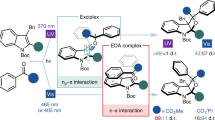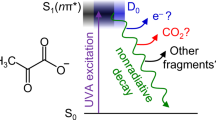Abstract
DURING the course of our recent work on the photochemistry of butyric acid and its methyl ester1, some spectroscopic confirmation was sought that their absorption spectra and those of the aldehydes and ketones are due to the same electronic transition. The absorption spectra are similar in form and have comparable extinction coefficients, but the absorption maxima of the acids and esters are displaced to lower wavelengths, as column 2, Table 1, illustrates. There is little doubt that they are due to the same transition, for the primary photochemical reactions are similar and the carbonyl group in the acids maintains its identity, although it is naturally modified by the neighbouring hydroxyl group2.
This is a preview of subscription content, access via your institution
Access options
Subscribe to this journal
Receive 51 print issues and online access
$199.00 per year
only $3.90 per issue
Buy this article
- Purchase on Springer Link
- Instant access to full article PDF
Prices may be subject to local taxes which are calculated during checkout
Similar content being viewed by others
References
Borrell, P., and Norrish, R. G. W., Proc. Roy. Soc. (in preparation).
Davies, M., and Thomas, O., Discuss. Faraday Soc., 9, 335 (1950).
Mulliken, R. S., J. Chem. Phys., 3, 564 (1935).
McMurry, H. L., J. Chem. Phys., 9, 231 (1941).
Sidman, J. W., Chem. Rev., 58, 689 (1958).
Borrell, P., (to be published).
Pauling, L., “The Nature of the Chemical Bond” (Cornell : New York, 1940).
Gillam, A., and Stern, E. S., “Electronic Absorption Spectroscopy” (Arnold, London, 1957).
Ley, H., and Arends, B., Z. Phys. Chem., B 4, 234 (1929).
Ley, H., and Arends, B., Z. Phys. Chem., B, 17, 177 (1932).
Saskena, B. D., and Kagarise, R. E., J. Chem. Phys., 19, 997 (1951).
Rieche, A., and Meister, R., Ber., 68, 1465 (1935).
Author information
Authors and Affiliations
Rights and permissions
About this article
Cite this article
BORRELL, P. A Correlation between the Shift in the Ultra-Violet Absorption Maxima and the Electronegativity of the Adjacent Atoms in some Aliphatic Carbonyl Compounds. Nature 184, 1932–1933 (1959). https://doi.org/10.1038/1841932b0
Issue Date:
DOI: https://doi.org/10.1038/1841932b0
Comments
By submitting a comment you agree to abide by our Terms and Community Guidelines. If you find something abusive or that does not comply with our terms or guidelines please flag it as inappropriate.



